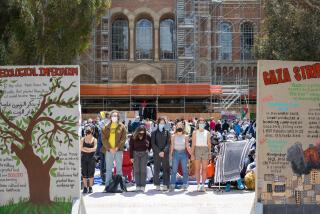‘60s kaleidoscope
- Share via
Flip to Page 131 of the new “The Sixties Chronicle” for this single sentence and you can’t be sure whether you’ve hit the rewind button or fast-forward: “We are people of this generation, bred in at least modest comfort, housed now in universities, looking uncomfortably to the world we inherit.”
This is the opening passage from the Port Huron Statement, the 1962 Students for a Democratic Society treatise that formed the theoretical basis for much of the student protest movement of the 1960s. That college students could write the same words today fuels the argument that some of the core issues from the 1960s -- namely, peace and social justice -- were never fully resolved.
But there was more to the decade than war and revolt, racism and defiance, as “The Sixties Chronicle” points out. There was rock ‘n’ roll and jazz, Hitchcock movies and “The Sound of Music,” drugs and the Wham-O Super Ball.
“If you try to visualize the ‘60s or teach the ‘60s, as I do, you’ll find that people bring their own slant to it,” said Tom Hayden, the primary author of the Port Huron Statement and a former California Assembly member now teaching an Occidental College class on political movements. “There’s been very little done, aside from this book, to let the decade present itself in its contradictions and complexity. I think the impact of 1,000 photographs has that effect.”
The book, which includes a preface from Hayden, follows an easy chronology over some uneasy times. But it also recalls the temporary distractions that give life dimension, from Arnold Palmer’s magical 1960 U.S. Open win -- he started the final day seven strokes back -- to the growing embrace of Pop art by David Hockney and others, to a publicity photo of Alan Young and a horse -- better known as Wilbur Post and Ed of CBS’ “Mister Ed” television show.
Still, the recurring theme is of unrest, with telling period photos of bombed streets from Vietnam to Aden, faces bloodied in protests from Selma to Paris, and the omnipresent symbols of the Cold War -- bomb shelters and Nikita Khrushchev embracing Fidel Castro.
Current political elders were largely forged in the caldron of the 1960s, and the passions that propel the current antiwar and antiglobalization movements were distilled from the peace and civil rights movements, Hayden believes. And it was also the birth of modern conservatism, with William F. Buckley and Barry Goldwater’s Young Americans for Freedom group (founded in 1960) offering a political home for those more appalled by the ‘60s protesters than what they were protesting.
But decades later, there’s also a sense of missed promise from the assassinations of the Kennedy brothers and Martin Luther King Jr., including a haunting photograph of Yolanda King that captures a daughter’s singular anguish on a day of national mourning.
“There is no one view of the ‘60s,” Hayden said, “and this book tries to pull it all together.”
More to Read
Sign up for our Book Club newsletter
Get the latest news, events and more from the Los Angeles Times Book Club, and help us get L.A. reading and talking.
You may occasionally receive promotional content from the Los Angeles Times.











